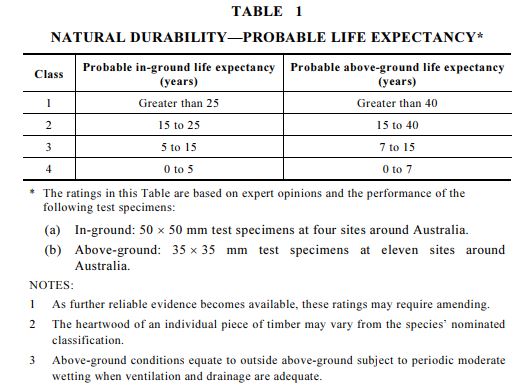Phone: 03 577 2395
C/- Marlborough Research Centre Trust, PO Box 875, Blenheim 7201


Natural durability is a complex parameter. It relates to the ability of wood to resist decay when in contact with soil. Organisms which cause wood to decay are fungi, which cause wood to rot, and boring insects.
Sapwood - the outer rings of wood in a tree trunk - is never durable. As sapwood cells die to become heartwood - the inner wood in a tree trunk - the cells become storage space for organic materials, or 'extractives'. Extractives produce the darker colour of heartwood in most tree species. Also, extractives give the heartwood its durability - that is, resistance to the fungal and insect attack that cause wood to decay.
Excellent natural ground-durability is a key feature of the NZDFI species selected for genetic improvement. NZDFI selected species are all in Class 1 or 2 based on the Australian Durability Standard.
Natural Durability Classes
Natural durability is defined as "the inherent resistance of a specific timber to decay and to insect attack". Natural Durability Classes provide the basis for rating the timber’s performance and longevity in contact with the ground when exposed to average environmental conditions. The classification system is based on the average life expectancy (in years) for any timber species, as shown below.
 (Standards Australia, 2003. Revised 2005. AS 5604 – Timber-Natural durability ratings.)
(Standards Australia, 2003. Revised 2005. AS 5604 – Timber-Natural durability ratings.)
Wood properties vary within and between species. Durability also depends on the ground conditions in which the timber is used. The classifications are therefore only a guide. Actual timber life will depend on the local ground conditions and other factors:
The durability of wood is traditionally determined by 'graveyard tests', where 50mm x 50mm wooden stakes are hammered into the ground and their decay level is measured annually. Lab-based fungal cellular tests are also used to measure wood decay.
More recently, wood scientists have adopted near-infra-red spectroscopy (NIR) to measure extractives in cores taken from growing trees. This provides an indication of the relative durability of trees while growing, and so can speed up selecting trees with high durability (which has been proven to be heritable in durable eucalypts) for breeding programmes.
Researchers at the School of Forestry have made good progress in understanding and measuring durability using NIR techniques. Read about their work in Our Science. All technical reports and journal articles produced by the wood quality research team are available in our Library.
C/- Marlborough Research Centre Trust, PO Box 875, Blenheim 7201